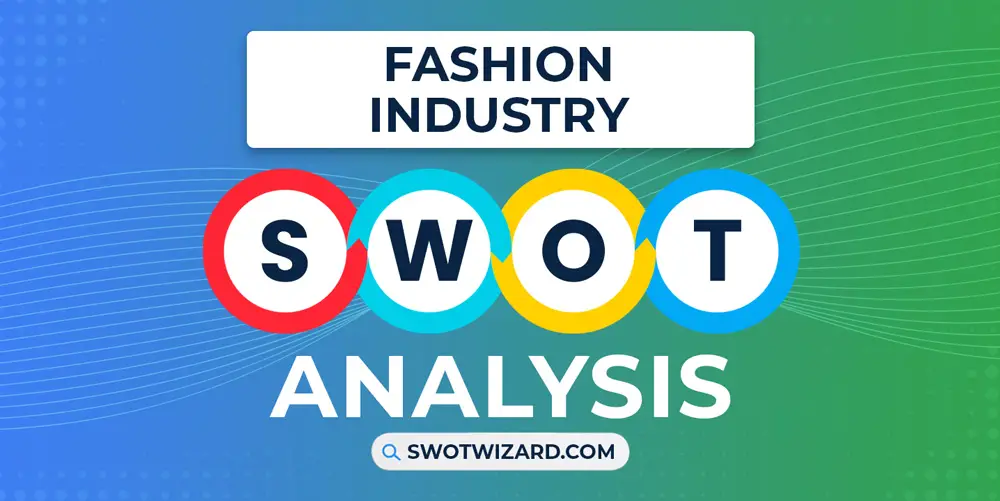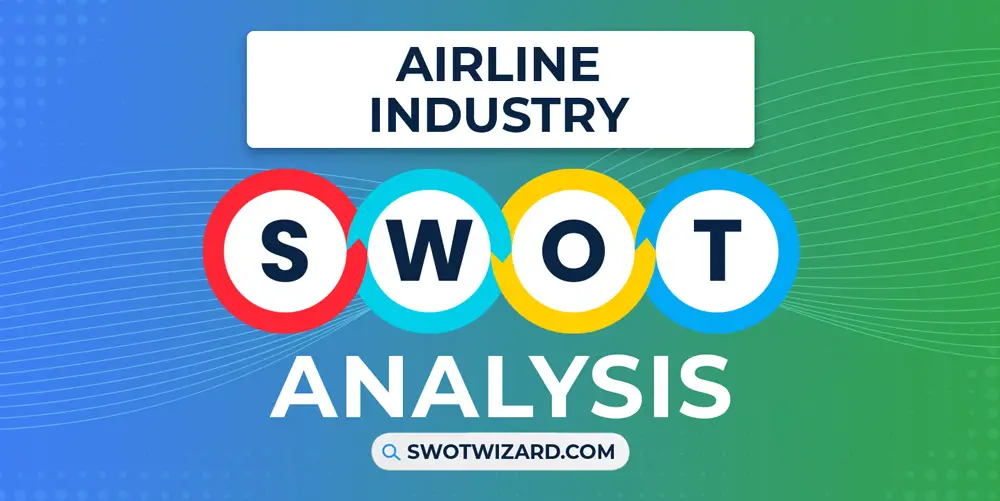The fashion industry orchestrates trends that shape personal expression, from haute couture to streetwear, and it’s a vibrant ecosystem of creativity and commerce, captivating consumers and reflecting cultural shifts. The industry has been built for hundreds of years, and we will get to know all about that in this fashion industry SWOT analysis.
Fashion Industry Overview
If we go back to ancient times, the fashion industry is rooted in ancient civilizations’ garments and has evolved into a multi-billion-dollar global phenomenon after thousands of years. Its history showcases constant innovation from the industrial revolution’s mass production to the present digital era, and is still growing.
Many established brands work collectively to make the industry more exciting. As a result, people are returning for more and new things that the industry has to offer, with millions of people being employed and billions being generated.
Competitors in Fashion Industry
Nike | Louis Vuitton | Gucci | Adidas | Zara | H&M | Lululemon | New Balance | Nordstrom | Macy’s | Primark
Did You Know?
The hoop skirt’s popularity in the 19th century led women to encounter issues passing through doors, prompting the invention of the revolving door.
Strengths – Fashion Industry SWOT Analysis
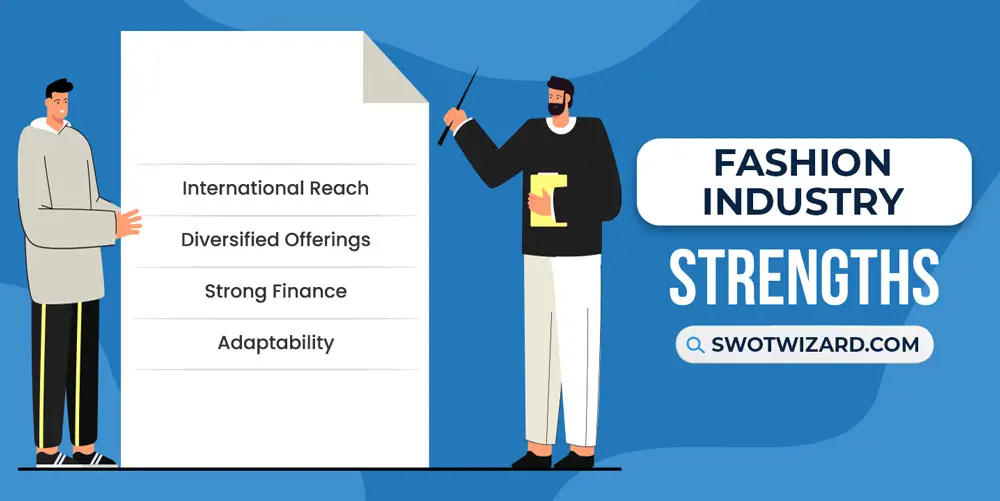
International Reach: There is not a single country in the world that the fashion industry hasn’t touched, whether it’s Vatican City or China, and continuing to cross borders effortlessly. Tons of iconic brands have been created over the years, and brands like Zara have achieved worldwide recognition, with over 3,000 stores across 96 countries, capitalizing on the global appeal of trends.
Diversified Offerings: The industry boasts an array of segments, from high-end luxury to affordable, fast fashion. H&M adeptly caters to budget-conscious shoppers, while Chanel remains synonymous with luxury, enabling brands to address a wide spectrum of consumer needs. Besides, some brands cater to everything a person can need, and sometimes that can be gender-based or geographic location.
Strong Finance: Fashion’s economic significance is profound, exemplified by the financial prowess of LVMH. Brands like H&M alone generated $22.02B in 2022, and their impressive revenue of over $768B in 2022 underscores the industry’s ability to generate substantial profits, attract investments, and contribute to global economies.
Adaptability: The industry is in a different position than it was a hundred years ago and not even a decade ago as fashion swiftly embraces change. During the pandemic, brands like Burberry and Prada promptly shifted focus to PPE production while preserving their quintessential style, illustrating the industry’s agility in responding to challenges.
Weaknesses – Fashion Industry SWOT Analysis
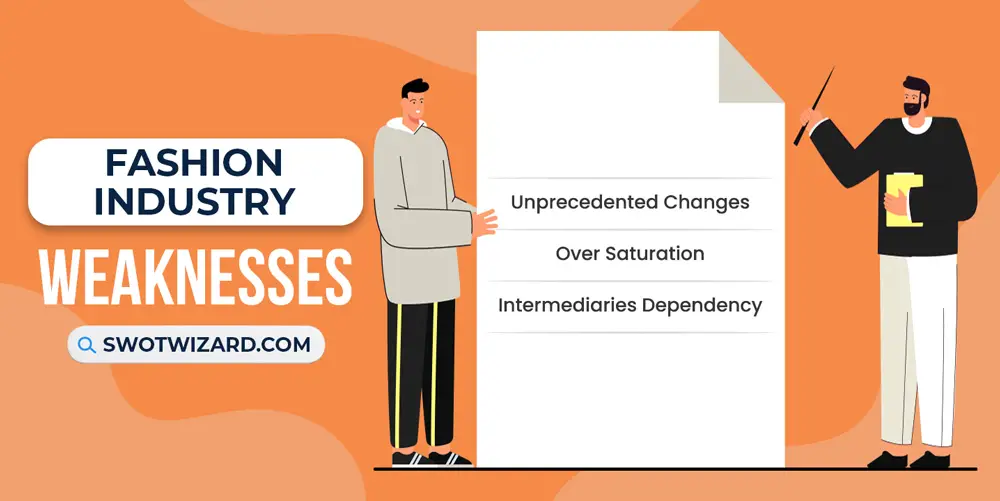
Unprecedented Changes: The rise of athleisure, e-commerce, and changing consumer values disrupt traditional fashion retail. If we look at the data in the last three years, during and after the covid, everything altered demand for formal wear, pushing brands to pivot towards loungewear and activewear to stay afloat.
Over Saturation: The market’s inundation with products from numerous brands leads to increased competition and dilution of uniqueness, and that’s what is happening in the fashion industry. The data shows over 100B pieces of clothing were produced globally in 2022, and Zara added over 20,000 new items annually, intensifying the challenge to stand out and maintain profitability.
Intermediaries Dependency: The reliance on intermediaries like wholesalers and retailers hampers direct consumer-brand connections. Major fashion brands, like over 50% of Ralph Lauren’s wholesale revenue, came from just three department store chains in North America, and this is the case for most fashion brands, limiting profit margins and control over the customer experience.
Opportunities – Fashion Industry SWOT Analysis
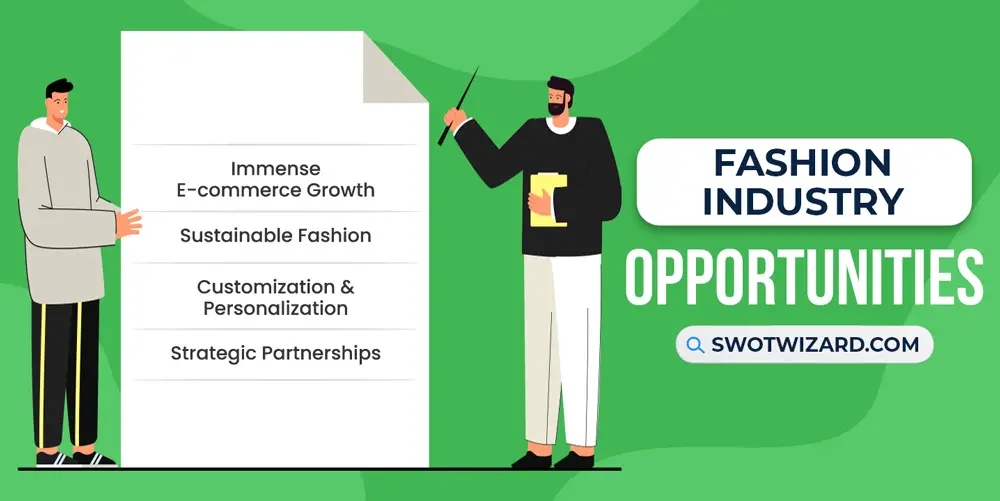
Immense E-commerce Growth: Online fashion retail has surged, accounting for 29% of total fashion sales in 2022 and growing at over 20% annually. Brands like ASOS and Zara have leveraged the trend, showcasing the potential to tap into a broader audience, reduce operational costs, and enhance customer convenience.
Sustainable Fashion: With rising eco-awareness, brands making sustainable materials and ethical sourcing commitments can attract eco-minded consumers, and 73% of global consumers are willing to pay more for sustainable products. Patagonia’s use of recycled materials exemplifies the trend, showcasing a golden chance for brands to align with socially responsible values.
Customization & Personalization: On-demand manufacturing, digital printing, and 3D modeling allow for customized and tailored clothing, leading to a 45% increase in demand for personalized fashion. Startups like Alton Lane and Dropel offer made-to-measure menswear, and Nike’s custom sneakers platform demonstrates the allure of tailored products.
Strategic Partnerships: Partnerships with social media influencers, athletes, celebrities, and even between and among different fashion brands can effectively engage customers, including millennials and Gen Z. A few years back, H&M collaborated with Balmain, and the products sold out in hours and Adidas saw a 67% sales spike for products promoted by Kanye West.
Threats – Fashion Industry SWOT Analysis
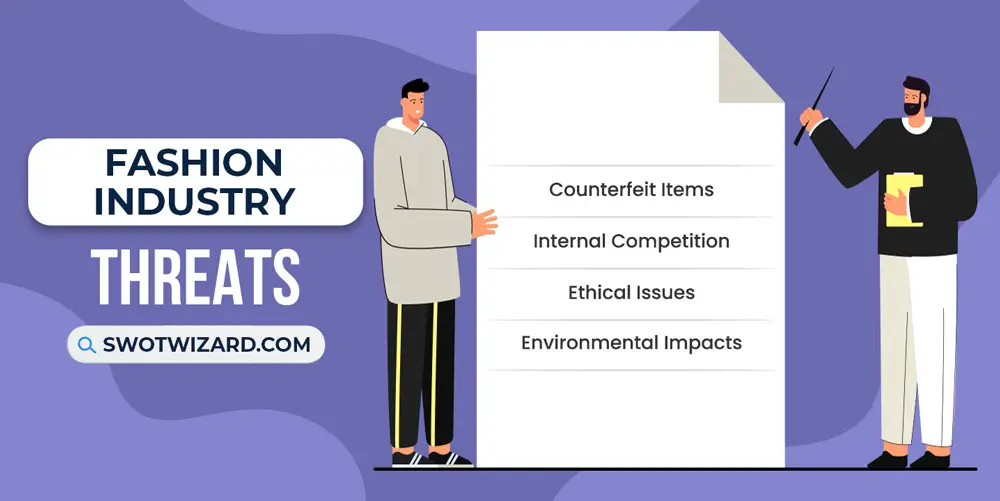
Counterfeit Items: The proliferation of counterfeit fashion products undermines brand integrity and revenue, accounting for 2.7% of global trade, worth over $500B annually and growing. As a result, major brands like Louis Vuitton lose over $6B to counterfeiters each year, diminishing exclusivity and causing substantial profit and sustainability.
Internal Competition: Many large fashion groups own competing brands that can cannibalize each other’s sales and overcrowded markets, and a plethora of fashion brands intensify rivalry. Brands like Louis Vuitton face internal competition from their parent company, LVMH’s other brands, potentially diluting their market share.
Ethical Issues: Labor exploitation, environmental waste, dangerous working conditions, and animal cruelty issues can severely damage brand reputations if not proactively addressed. A notable case was the Rana Plaza disaster 2013, where an unethical factory collapse exposed the industry’s labor issues.
Environmental Impacts: Textile dyeing and treatment generate immense pollution, and the fashion industry is responsible for around 10% of global carbon emissions. Brands like H&M, Zara, Forever 21, Uniqlo, etc., have faced criticism for their environmental footprint, raising concerns about the industry’s sustainability.
[Bonus Infographic] SWOT Analysis of Fashion Industry
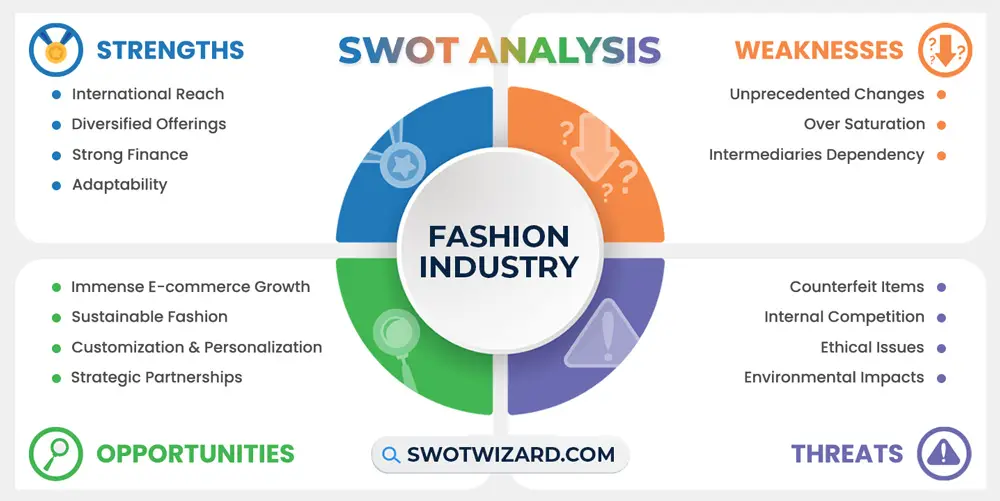
Recommendations for Fashion Industry
In this fast-moving and constantly changing fashion industry, all the stakeholders, especially the major brands, must be cautious and fast to move forward with the trends.
- Showcase the efforts to reduce waste, use organic materials, and support ethical labor practices all over the industry.
- Embrace the online shopping surge by optimizing your e-commerce platforms, and offer robust omnichannel experiences, virtual try-on, and innovative use of augmented reality.
- Pursue strategic partnerships with social media influencers, celebrities, and athletes to access their follower base for branded content and endorsements.
- Enable customization and personalization through on-demand manufacturing, digital printing, and 3D modeling.
Frequently Asked Questions (FAQs)
Which city is the world of fashion?
Paris City is the world of fashion.
What is the fashion capital of Asia?
Tokyo is the fashion capital of Asia.
Final Words on Fashion Industry SWOT Analysis
The fashion industry, a dynamic realm of creativity and commerce, faces challenges from counterfeits to sustainability concerns. Yet, opportunities like e-commerce growth, sustainability efforts, and strategic partnerships offer paths to innovation. Adapting with integrity and embracing change will shape its future as a force of style and responsibility.
References
- From suits to sweatpants during and after the pandemic. (2021, December 2). CBI.
- 2022 Global Ecommerce Report: Fashion and Apparel. (n.d.). BigCommerce.
- Lai, O. (2022). 7 Fast fashion companies responsible for environmental pollution in 2022. Earth.Org.

